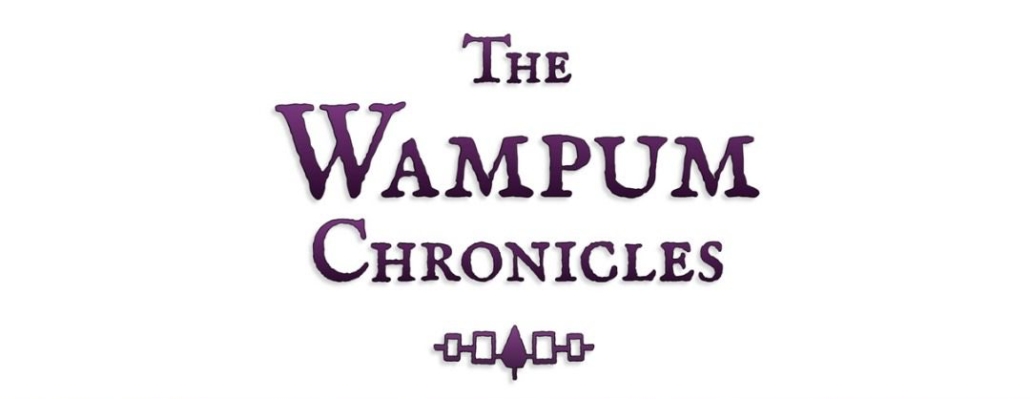
Land Where The Partridge Drums
A History of the Akwesasne Mohawk Nation
In the Shadow of Serpents: Trials and Tribulations of the Early 1800’s
Written and illustrated by Darren Bonaparte
Mohawk elders still tell the Prophecy of the Silver and Gold Serpents, in which two young hunters bring home a pair of odd- looking snakes (some say lizards) they find glistening in the sun on the banks of the sea. Most of the people in the village become enamored with them, much to the dismay of an elder, and they build a small pen to keep them in. The silver and gold serpents are ravenously hungry and the people soon forsake their own needs to make sure the mysterious creatures are fed. In no time at all the creatures outgrow their stockade and begin to eat the villagers themselves, then they move on, one going north, the other south. By the time they return they are as large as mountains and have left trails of death and destruction in their wake.
Many people believe this prophecy to be a warning of what happened when European colonists came to America. For the Mohawks, this would seem to be the case. As we have seen in the first two chapters of this work, the Mohawks and our
Haudenosaunee brothers have always been caught between at least two colonial powers: first it was the Dutch and the French, then the English and the French, then the Americans and the English, and finally the Americans and Canadians. Although these “serpents” were different, their effects on us were identical. Once mesmerized by the glitter of their outward appearances, a few of our people went against the will of their elders and helped the foreign powers gain a foothold in America, a mistake that left the entire continent open for conquest.
The analogy of serpents is a fitting one. It allows us to trace the movements of the colonial powers on the continent. As we have seen, the French serpent, bloodied and defeated in the French and Indian Wars, was neutralized and restrained in Quebec while England gave birth to (and was ultimately driven northward by) its offspring, the United States, in the American Revolution.
This chapter continues the story of the serpents with the “rematch” between England and her serpent offspring, the United States, in the War of 1812. It also chronicles the “reawakening” of the French serpent and its resumption of hostilities against the English serpent in the Patriote Rebellion of the 1830’s. As it was in previous conflicts, our own Mohawk people were more or less forced to heed the call of war on both occasions. By doing so they forgot the lessons of those who came before and “fed the serpents” in their own time. Just as before, Mohawk unity on what course of action to take was impossible to maintain.
An Account of the Emergence of a Mohawk Prophet on the Six Nations Reserve
…In the autumn of 1798 a young Mohawk Indian of Grand River, fell into a kind of trance for 24 hours or more, who had dreamed a dream and had many visions in which he had a particular interview and conference with Thauloonghyauwangoo which signifies Upholder of the Skies or Heavens, who from time immemorial or before the formation of the Island, or America, existed, and who placed it upon the back of a great tortoise, chief of the Turtle tribe. In the conference which this young Indian had with the Upholder of the Skies, the latter made grievous complaints of the Base and ungrateful neglect of the Five Nations (the Seneca excepted) in withholding the homage due to him and the offering he was wont to receive from their fathers, as an acknowledgement for his guardianship. Many were the evils which had come upon them in consequence of this neglect. Sickness, epidemic disorders, losses in war, unfruitful seasons, scanty crops—unpleasant days. The character of this young man was so unblemished and remarkable for a sedate and reflecting mind, that when he declared his vision in a serious and affecting manner, it immediately gained almost universal credit in the settlement. Brant, from political motives, found himself obliged to give his consent to a sacrafice and offering to the Upholder of the Sky, with this condition, that should not be considered as setting aside the Christian religion. The sacrafice with all its appendages was performed—Christian and Pagan all attended, tho none but the Pagans partook of the feast. It seemed to diffuse new and general joy throughout the whole settlement.
From the Journal of Rev. Samuel Kirkland, Feb. 26, 1800, as quoted The Valley of the Six Nations: A Collection of Documents on the Indian Lands of the Grand River (1964).
Next week:”Slums in the Wilderness”
By Darren Bonaparte, historian and author of The Wampum Chronicles. Reprinted with permission.
Darren Bonaparte is a cultural historian from the Akwesasne First Nation. He is a frequent lecturer at schools, universities, museums, and historical sites in the United States and Canada. He has written four books, several articles, and the libretto for the McGill Chamber Orchestra’s Aboriginal Visions and Voices. Darren is a former chief of the Mohawk Council of Akwesasne. He is the creator of The Wampum Chronicles and historical advisor to film and television. He currently serves as the Director of the Tribal Historic Preservation Office of the Saint Regis Mohawk Tribe.














